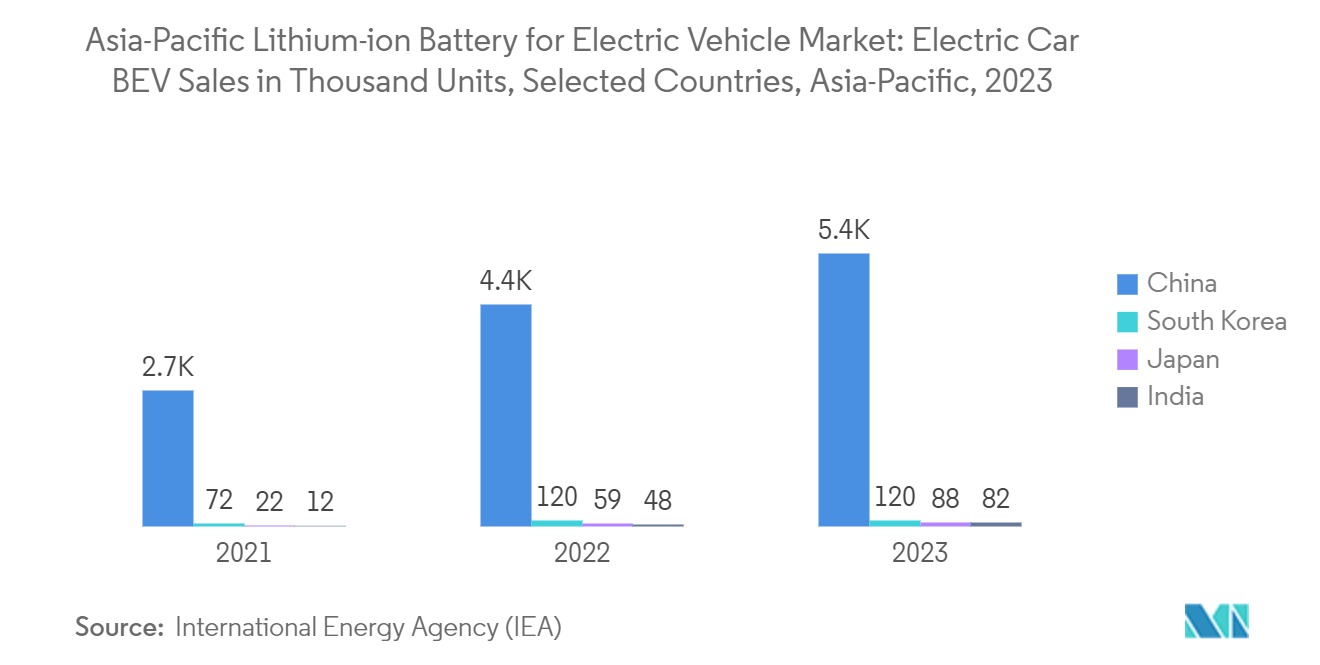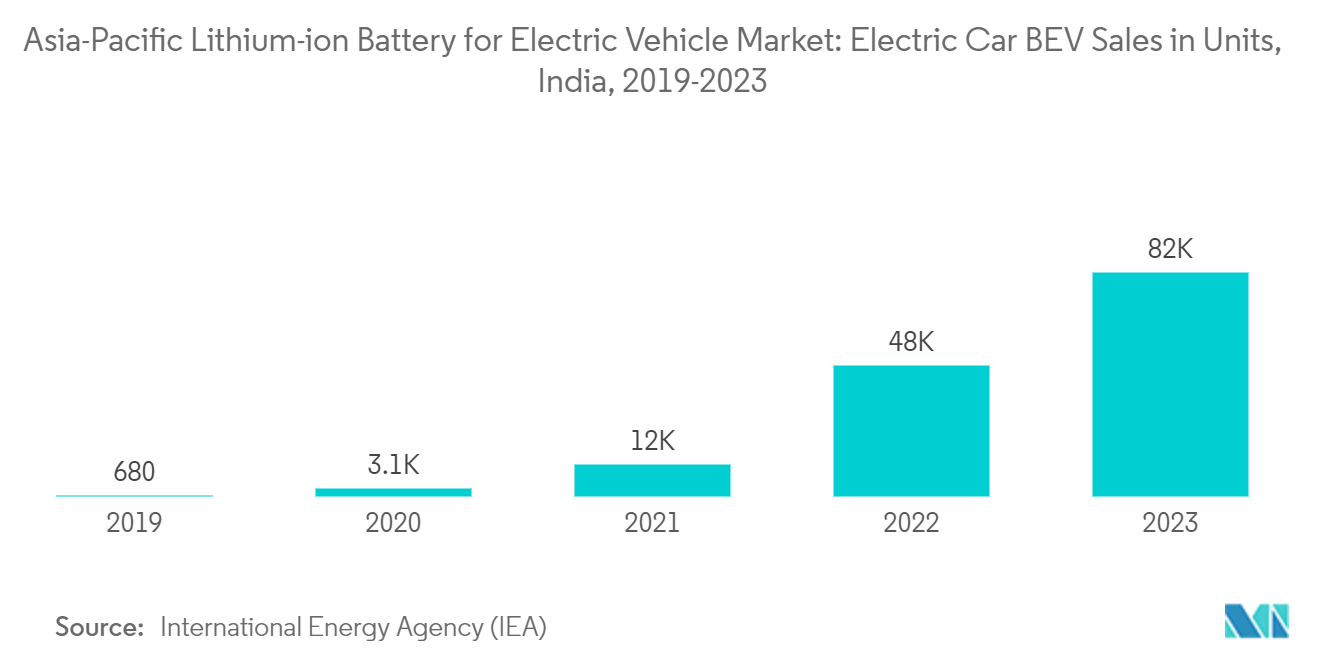Market Trends of Asia-Pacific Lithium-ion Battery For Electric Vehicle Industry
The Battery Electric Vehicle (BEV) Segment to Witness Significant Growth
- Battery electric vehicles (BEVs) are also commonly referred to as electric vehicles with an electric motor. BEVs are fully electric vehicles that typically do not include an internal combustion engine (ICE), fuel tank, or exhaust pipe and rely on electricity for propulsion. The vehicle's energy comes from a battery pack, which is recharged from the grid. BEVs are zero-emission vehicles, as they do not generate harmful tailpipe emissions or air pollution hazards caused by traditional gasoline-powered vehicles.
- The automotive industry in Asia-Pacific has been transforming over the years, with electric vehicles, particularly battery electric vehicles (BEVs), gaining momentum and popularity. With growing technological advancements, government support, and increasing environmental concerns, BEVs have emerged as a promising solution to address the challenges of climate change and reduce reliance on fossil fuels.
- In recent years, the adoption of battery-electric vehicles has grown significantly worldwide. The improvement of battery technology has led to extended driving ranges and a surge in charging infrastructure that is helping overcome the initial entry barriers. Further, automakers such as Tesla, BYD, Tata, Toyota, and Honda have been playing a vital role in popularizing BEVs, offering affordable models that appeal to a broader range of consumers.
- According to the International Energy Agency (IEA), the battery electric vehicle (BEV) car stocks in China stood at around 16 million units in 2023. Similarly, in the same year, countries such as India, Japan, and South Korea had approximately 0.15 million, 0.29 million, and 0.46 million units of BEV car stock, respectively. Similarly, in 2023, BEV sales in China stood at over 5.4 million. India sold around 82,000 units of BEV cars, while Japan and South Korea sold 88,000 and 120,000 units of BEV cars, respectively. As the sales of BEVs continue to rise, the demand for EV batteries, such as lithium-ion batteries, has become increasingly vital.
- Moreover, being one of the largest markets for BEV vehicles, Asia-Pacific is also the largest EV battery manufacturing region in the world. China led from the front with an EV battery demand of about 417 GWh per year, or about 54% of the world demand in 2023, recording a surge of over 32% from 2022. This highlights the importance of the region's dominance in EV battery technologies. Similarly, as per the International Energy Agency (IEA), the lithium-ion battery manufacturing capacity in the Asia-Pacific region is expected to grow significantly in the coming years, with China leading the way. The agency estimated that the Chinese lithium-ion battery manufacturing capacity will rise to 4.65 TWh in 2030 from around 1.20 TWh in 2022.
- To accelerate the adoption of BEVs, countries have been implementing various initiatives and incentives. For example, to reduce dependency on imported advanced chemistry cell (ACC) batteries for electric vehicles, the Indian government approved a Production Linked Incentive (PLI) Scheme in early 2021 for the manufacturing of ACCs in the country. The total outlay of the Scheme is USD 2.12 billion for five years. The scheme envisages establishing a competitive ACC battery manufacturing setup in the country (50 GWh). In addition, 5 GWh of niche ACC technologies is also covered under the scheme. Such initiatives are supporting the demand for lithium-ion batteries for EV applications.
- Further, Southeast Asian countries such as Thailand, Indonesia, Singapore, Malaysia, and the Philippines are expected to see rapid growth in the adoption of lithium-ion batteries due to the increasing prevalence of EVs and government initiatives to accelerate EV use. For example, Indonesia has an ambitious target of having EVs make up 20% of all car sales by 2025, and the Indonesian government aims for 600,000 EVs to be domestically produced by 2030. Such targets are translated into different milestones within the EV supply chain, including the lithium-ion batteries market.
- In early 2024, the EV Board in Thailand approved the second phase of the EV Package, known as EV 3.5, for four years (2024-2027) to promote the EV industry's continuous progress and facilitate investment opportunities in EV manufacturing in Thailand for new players. The package aims to boost investments covering the entire EV industry ecosystem. As part of the package, the Thai government will offer subsidies for the purchase of electric cars, electric pickup trucks, and electric motorcycles based on the vehicle types and battery capacities. Thailand's continuous EV promotion package since 2017 has resulted in investments in the EV industry worth USD 1.8 billion in manufacturing BEVs, battery electric motorcycles, EV parts and components, and charging stations.
- Therefore, due to the factors mentioned above, the BEV segment is likely to dominate the lithium-ion battery for electric vehicle (EV) market during the forecast period.

India to Witness Fastest Growth
- India is emerging as one of the fastest-growing markets for lithium-ion batteries, driven by a strong push toward the adoption of electric vehicles (EVs). For example, according to the International Energy Agency (IEA), battery electric vehicle (BEV) sales in India reached around 82,000 units in 2023, an increase of over 70% from 2022. Additionally, the Indian government aims for an EV target of 30% of newly registered private cars, 40% of buses, 70% of commercial cars, and 80% of 2-wheelers and 3-wheelers by 2030. These are likely to create a substantial demand for EV batteries, such as lithium-ion batteries, in the coming years.
- Besides, the government has also implemented a range of policies and incentives to encourage the shift from traditional internal combustion engine vehicles to EVs, significantly boosting the demand for lithium-ion batteries. With initiatives such as the Faster Adoption and Manufacturing of Hybrid and Electric Vehicles (FAME) scheme, India is making substantial investments in charging infrastructure, battery manufacturing, and subsidies for EV buyers, creating a conducive environment for market growth.
- More recently, in March 2024, the Indian government approved a new USD 500-million-worth EV Policy, offering a range of incentives to draw investments from global EV companies and position India as a prime manufacturing hub for state-of-the-art EVs. Other objectives include providing Indian consumers with access to cutting-edge EV models, expanding the Make in India ecosystem, lowering costs of production, and fostering a competitive domestic auto manufacturing industry.
- Various local and international players are investing in the Indian lithium-ion battery market, aiming to capitalize on the country's burgeoning energy storage needs and its transition toward sustainable solutions. For example, in April 2022, battery behemoth Exide Industries announced plans to invest about USD 718 million to set up a lithium-ion cell manufacturing plant in Karnataka. In its first phase, a 6 GWh lithium-ion cell manufacturing facility is likely to become operational by 2024, gradually expanding to a 12 GWh capacity integrated lithium-ion battery facility over the next few years.
- Furthermore, in April 2023, the battery technology startup Log9 Materials inaugurated the country's first lithium-ion cell manufacturing facility in Jakkur, Bengaluru. The plant has an initial capacity of 50 MWh. The company is also working on expanding its lithium-ion cell manufacturing capacity to 1 GWh and its battery pack manufacturing capacity to 2 GWh by the first quarter of 2025.
- Overall, with a large consumer base, supportive policies, and increasing progress in the batteries manufacturing, the lithium-ion battery for electric vehicle (EV) market in India is poised for further growth in the coming years.


